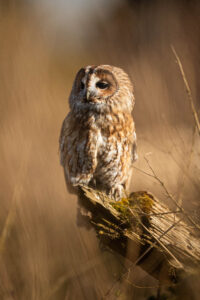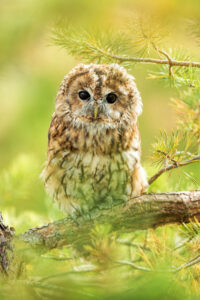Tawny Owl Hoot
The Tawny Owl – Europe’s Classic “Twit-Tuwoo”
If you close your eyes and imagine the sound of an owl on a dark night, chances are you are thinking of the Tawny Owl. Its famous “twit twoo” has echoed through European folklore, ghost stories and countryside walks for centuries. Yet while its voice is familiar, the bird itself remains a mystery to many.
Secretive, well-camouflaged and mostly nocturnal, the Tawny Owl is far more often heard than seen. With its rounded head, soulful dark eyes and stocky build, it is a bird that has fascinated humans for as long as we have shared the same woods and fields.
In this article, we’ll take a closer look at the Tawny Owl – its habits, appearance, folklore, and the role it plays in our landscapes.
A Widespread but Elusive Resident
The Tawny Owl (Strix aluco) is one of the most common owls in Europe. It ranges from the British Isles across the continent into Russia and parts of Asia.
Oddly, it is absent from Ireland – one of the great curiosities of European natural history. While Barn Owls, Long-eared Owls and Short-eared Owls occur there, the Tawny has never colonised.
Across its range, it is a bird of woodlands, parks, large gardens and even churchyards. Wherever there are mature trees with cavities, the Tawny Owl can make a home.
Despite its abundance, many people live near Tawny Owls without ever seeing them. Their camouflage allows them to vanish against tree bark, and by day they sit motionless, blending perfectly with their surroundings.
What Does a Tawny Owl Look Like?
The Tawny Owl is a medium-sized owl, around 40 cm tall, with a wingspan just over a metre. Its plumage comes in two main colour forms – reddish-brown or grey-brown – both intricately patterned to resemble the bark of a tree.
Unlike the bright yellow eyes of many owl species, the Tawny has deep, dark brown eyes. Stare into them and you might feel as though you’re gazing into the very heart of the forest.
Its rounded head and lack of “ear tufts” give it a distinctive profile. When hunched against a tree, it can look like part of the trunk, with only its eyes betraying its presence.
 Silent Hunters of the Night
Silent Hunters of the Night
Tawny Owls are consummate nocturnal hunters. At dusk, they emerge from their roosts and begin to patrol their woodland territories.
They rely on a combination of:
- Extraordinary hearing – their ear openings are asymmetrical, allowing them to pinpoint the exact location of a sound.
- Silent flight – their wing feathers have fringed edges that break up turbulence, making their flight almost noiseless.
- Stealthy patience – they often sit quietly on a perch, listening for the rustle of prey below.
Their diet is varied and opportunistic. The bulk consists of small mammals – voles, mice and shrews – but they also take young rabbits, frogs, beetles and even small birds roosting at night.
Like most owls, they swallow small prey whole and later regurgitate pellets of fur, feathers and bone. These pellets are often found beneath favourite perches and can be dissected to reveal the diet of the local owl family.
 The Breeding Season
The Breeding Season
The Tawny Owl’s nesting season begins early. By late winter, males are already hooting to establish territories.
Pairs typically nest in tree cavities, though they will also use old crow or buzzard nests, or man-made nest boxes. The female lays 2–4 eggs and incubates them for about a month while the male brings food.
Chicks hatch in fluffy white down. Within a few weeks they are too large to remain in the nest cavity and begin their famous branching stage. At this point, they clamber out onto nearby branches, still unable to fly properly.
It is common in spring to see – or more often hear – a gangly young Tawny Owl calling from a tree, watched over by parents that are not afraid to dive-bomb intruders who get too close. Many an unsuspecting naturalist has felt the talons of a protective Tawny parent brushing past their head.
The Famous “Twit-Tuwoo”
No description of the Tawny Owl is complete without mention of its call.
In truth, no single Tawny makes the complete “twit twoo” sound. Instead, it is a duet between male and female:
- The male gives a drawn-out, resonant “hoo-hoo-hoo-hoo”
- The female replies with a sharp “kew-wick”
Together, the alternating calls create the classic “twit twoo” that has become the symbol of owls in the European imagination.
This duet plays a vital role in pair bonding and territory defence. It also provides one of the most atmospheric soundscapes of the night woods.
Owls in Folklore and Literature
The Tawny Owl has a long and colourful place in human culture.
- Folklore: In many parts of Britain, hearing a Tawny Owl was once considered a bad omen, even a harbinger of death. Yet in other traditions, the owl was seen as a wise guardian of the night.
- Shakespeare: In Love’s Labour’s Lost, he refers to “the owl for all his feathers was a-cold, the parson’s saw” – linking its call to winter nights.
- Children’s stories: The kindly “Owl” of Winnie the Pooh is often imagined with the Tawny’s round features and nocturnal wisdom.
- Ghost stories: Its call has been used for centuries to create atmosphere in tales of haunted woods and lonely moors.
The dual reputation of the Tawny Owl – both sinister and wise – reflects the way humans have projected our own fears and hopes onto this mysterious bird.
What does a Tawny Owl look like?
Tawny Owls are medium-sized with reddish-brown or grey-brown plumage and large dark eyes. Their rounded heads lack ear tufts, giving them a distinctive look. See more images
Why do Tawny Owls say “twit twoo”?
The famous “twit tuwoo” is a duet. The male hoots a deep “hoo-hoo” while the female answers with a sharp “kew-wick,” creating the classic combined sound.
Where do Tawny Owls live?
Tawny Owls are found across Europe and parts of Asia, living in woodlands, parks and gardens. They are absent from Ireland but common in Britain.
What do Tawny Owls eat?
Tawny Owls hunt mainly small mammals like voles, mice and shrews, but also frogs, insects, slugs, worms and small birds. They are stealthy night hunters.
Are Tawny Owls dangerous?
Tawny Owls are not a danger to humans but will fiercely defend their nests. Protective parents have been known to swoop at people who approach too closely.
Tawny Owls and Humans
Though generally shy of people, Tawny Owls have adapted well to human-altered landscapes. They are now common in city parks, suburban gardens and even old churchyards.
Their biggest threats come from:
- Loss of mature trees with natural nesting holes
- Traffic collisions, especially at night
- Garden hazards such as barbed wire and netting
Conservation efforts focus on providing nest boxes and protecting large old trees. Tawny Owls readily accept artificial nest sites, and countless children have been thrilled to watch owlets ringed or studied by local bird groups.
An Owl Without Borders
Unlike some owls that migrate long distances, Tawny Owls are highly sedentary. Once established in a territory, they often remain there for life. This can make them wonderfully familiar neighbours for those lucky enough to live in their domain.
Because of this loyalty to place, they have become symbols of home and belonging in many rural communities.
Why the Tawny Owl Matters
The Tawny Owl is far more than a spooky night voice. It is an essential part of Europe’s ecosystems, keeping rodent populations in check. It is also a living link to our cultural past – the “twit twoo” that has inspired poets, playwrights and storytellers for centuries.
For those who have never seen one, the call alone can be enough to stir the imagination. But for those who catch a glimpse – a rounded shape melting out of the darkness, silent wings brushing past – the experience is unforgettable.
Conclusion
The Tawny Owl is the classic owl of European folklore: mysterious, haunting and familiar all at once. Abundant but unseen, it continues to share our woods and gardens, a nocturnal neighbour whose voice ties us to the timeless rhythms of the natural world.
Next time you hear the “twit twoo” on a still night, remember that it is not just a sound effect – it is the living song of one of Europe’s most enduring wild companions.



 Silent Hunters of the Night
Silent Hunters of the Night The Breeding Season
The Breeding Season